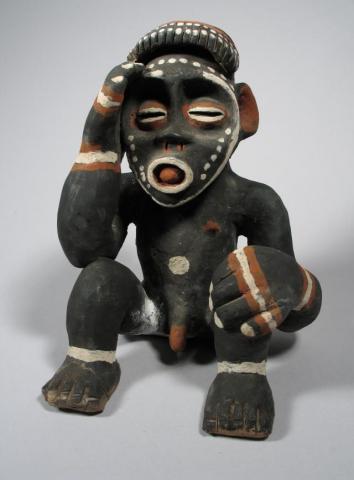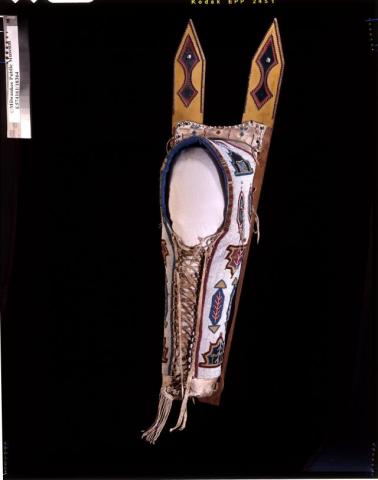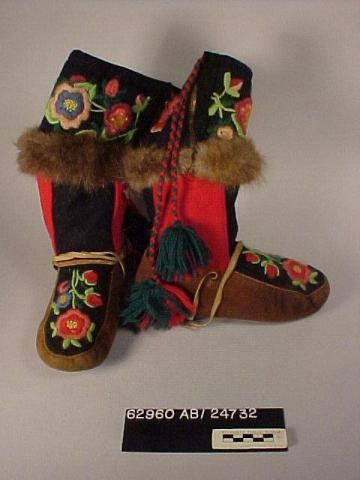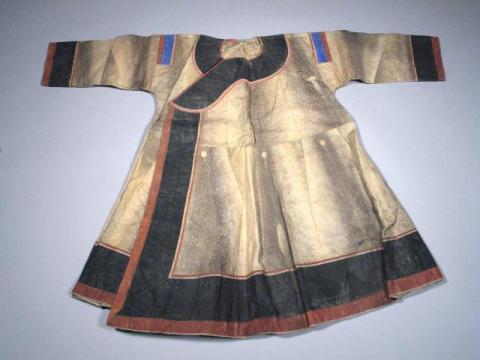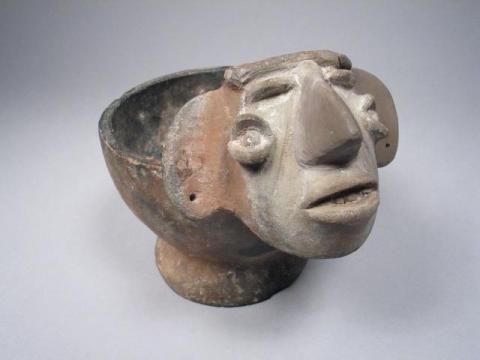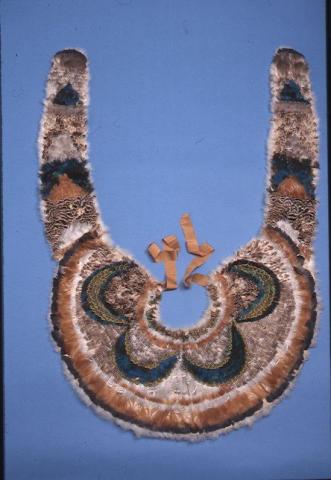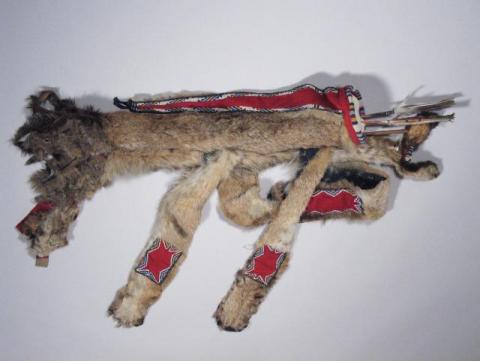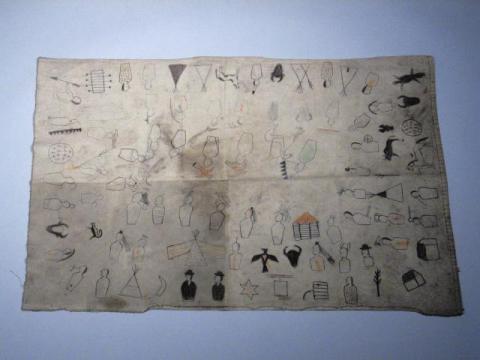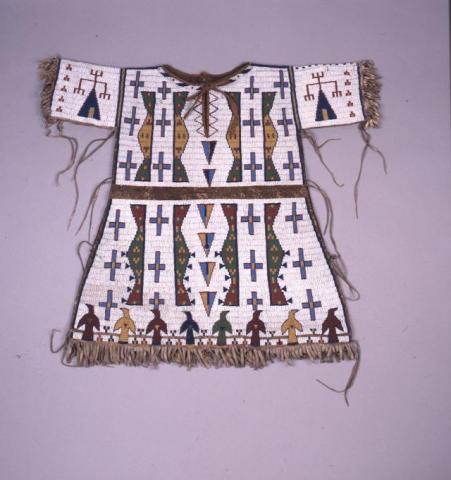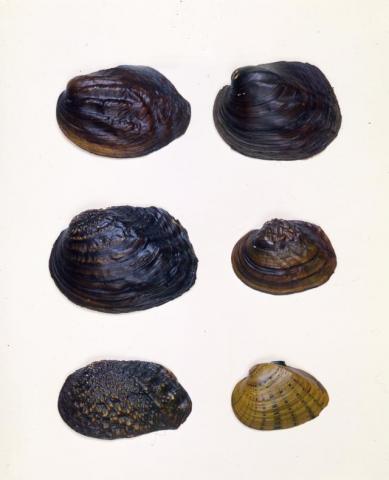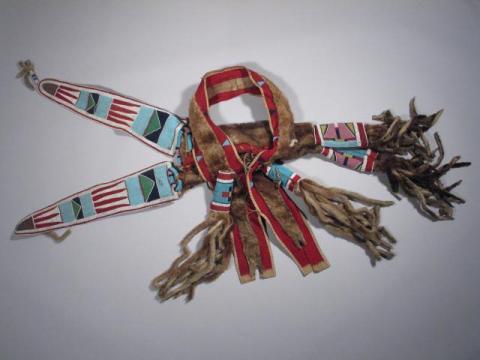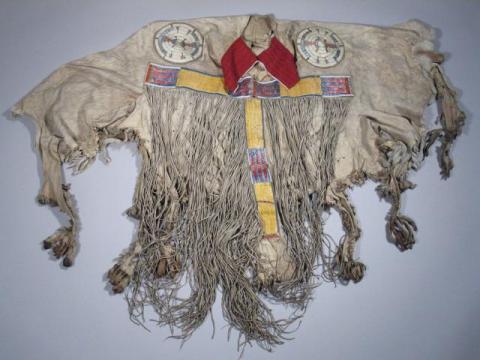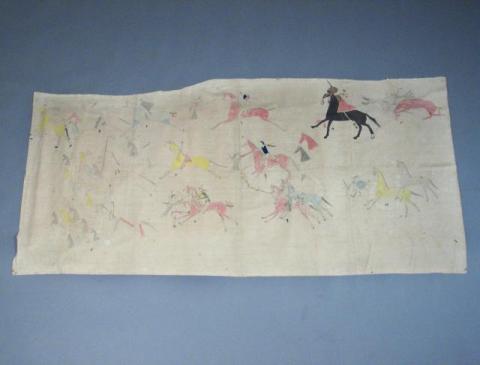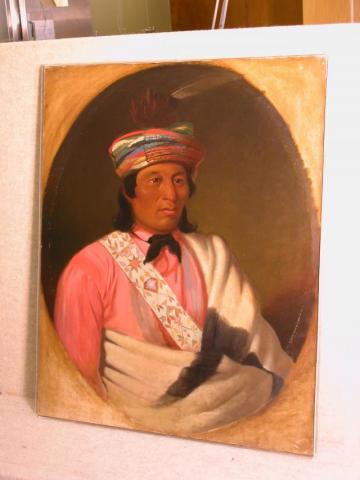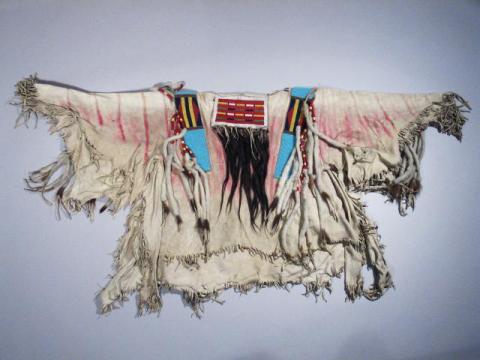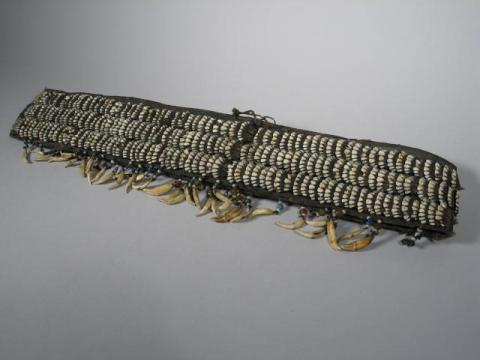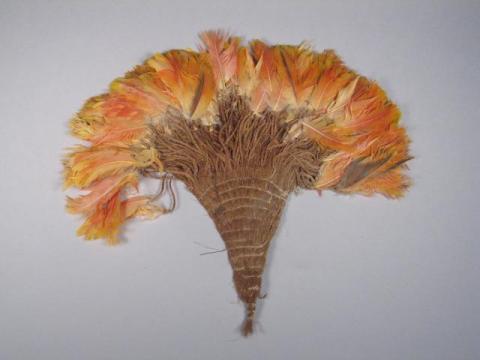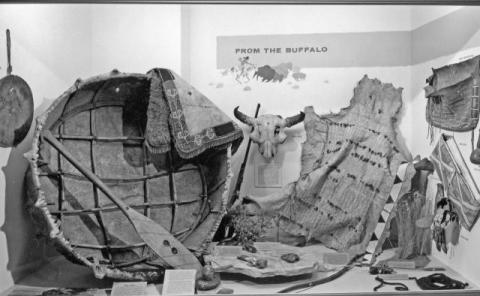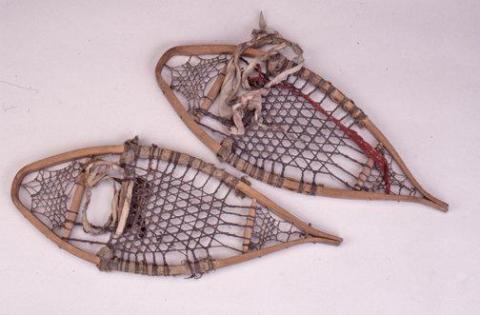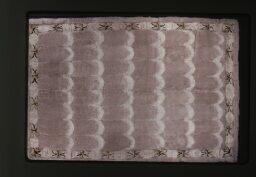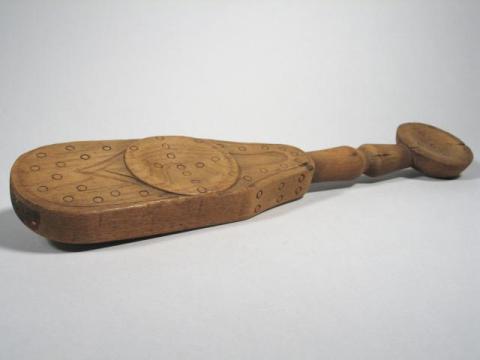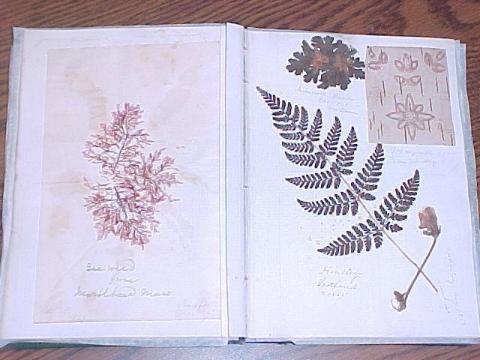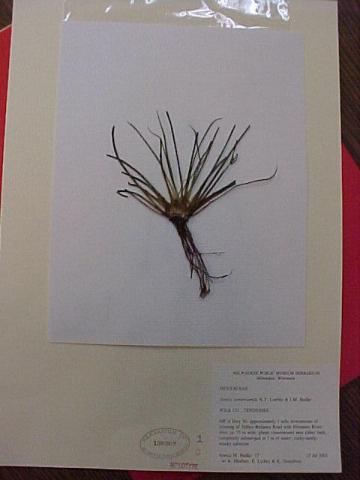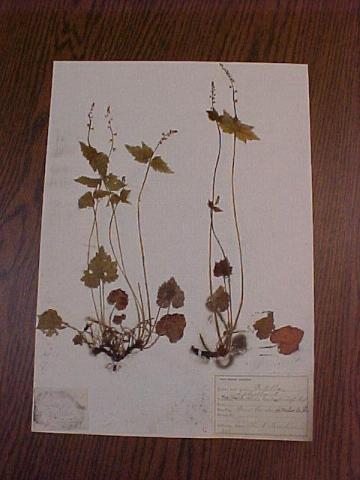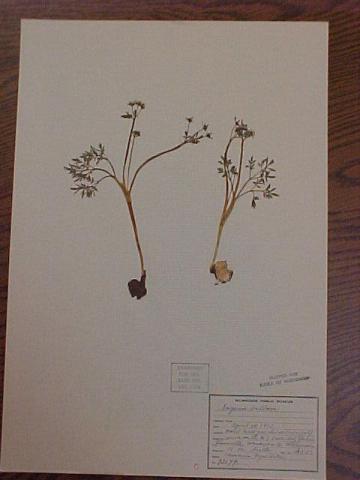MPM's curatorial and collections staff have selected more than 100 important, unique or interesting objects to highlight from the more than 4 million items in the Museum's care. These items reflect the depth and breadth of the collections.
Many of the items featured below are not on exhibit due to their fragile nature. One of the Museum's primary goals is to preserve objects for generations to come.
As a virtual exhibit, we can share with people around the world our most rare and intriguing items without harm to them.
The Mambila (Mambilla) are an agricultural group that inhabits northern Nigeria and western Cameroon. Gilbert Schneider of Ohio University collected in the Mambila grasslands of northern Nigeria from 1947 to 1951. Schneider tried to obtain materials relating to all aspects of Mambila life ranging from ancestral objects, such as this terra cotta shrine figure, to clothing. He kept detailed records on how the items were used by the Mambila, key information for museum collections. In addition to the Mambila exhibit in the Museum's African hall, see the Museum's webpage on the largest Mambila collection outside of West Africa. Learn more about this collection here.
This cradleboard and cover were collected in Oklahoma City by George Gorton of Racine, WI who donated it to the Milwaukee Public Museum in 1962. It was made by a master beadworker named Doyetone around 1904 for her grandson William "Bill" Bear.
The Kiowa are a Plains tribe that traditionally hunted buffalo in the area that is now Oklahoma and Kansas. Cradleboards and covers were used to carry infants while freeing the hands of the mothers while they work. This particular cradleboard is very intricate and in comparison to most cradleboards. The cradleboard, with a blue silk lining, features a leather cover that is almost entirely decorated with beads in floral and corn motifs.
Dr. Nancy Oestreich Lurie, then with the University of Wisconsin-Milwaukee, collected these items in 1967 from the Tłįchǫ (tɬhĩtʃhõ), formerly called Dogrib, for the Milwaukee Public Museum during a research trip with Dr. June Helm of the University of Iowa. The Tłįchǫ live in the Northwest Territories, Canada between Great Slave Lake and Great Bear Lake. Dr. Lurie and Dr. Helm were the first anthropologists to conduct extensive ethnological research with the Tłįchǫ. The Museum’s collection reflects a variety of aspects of Tłįchǫ domestic life.
The Milwaukee Public Museum purchased this coat from the Commercial Museum in Philadelphia, PA in 1919. Thought to be collected in the 1890s, this child's coat is made from fish-skin and decorated with a red and black border. Fish-skin coats are warm and waterproof, and are typically used as a kind of raincoat, usually large enough to be worn over a skin or bird parka for added protection from the wind and rain. Garments made from fish-skins are more often used by groups that live near rivers or the sea. Intact fish-skin clothing from such an early date is quite rare.
The Lacandon are an indigenous Mayan-speaking group living in the Mexican state of Chiapas. Today, only 300-500 Lacandon remain. One of the few groups not fully colonized by the Spanish, the Lacandon retained their indigenous religion until recently. The Museum's collection includes 113 objects widely representative of the group's material culture. Peter Thornquist collected most of the items in 1979 while visiting the Lacandon village of Metzabok, Mexico. The collection is important since it reflects items before tourism encroached the area. The Milwaukee Public Museum currently has a webpage on the Lacandon collection and culture. Also, see the Lacandon exhibit in the Latin American Hall on the Museum's Third Floor.
This feather cape was bought at an auction in England by William Sturtevant in 1987 with funds from the Milwaukee Public Museum's Friends of the Museum. It is believed to date to the 1830s and was made as part of the Iroquois "whimsy" complex, possibly by the Ottawa or Huron. The cape's feathers come from male and female mallard, gadwell, peacock, goose, and pheasant. The cape is sewn together with feathers and the neck ties are made from yellow silk. It is thought that the cape was produced for sale specifically to Europeans, as it matches the European fashion requirements of that time. However, the techniques utilized are based on older traditions of the tribes. At least 50 or so capes of this type are known to exist and few are in such good condition.
As an incredibly ornate piece of hunting equipment, this quiver and arrow set that came to the Museum in 1900 is a stunning example of Comanche craftsmanship. The shafts of all the arrows are stained a different color and are adorned with feathers. The quiver itself is made from cougar fur and has a fringe of cougar skin pieces that hang from the bottom. White, yellow, red, and blue beads are woven in a geometric pattern on the shoulder strap and the fringes.
This large cotton cloth covered in drawings from the Rosebud Reservation in south-central South Dakota is known as a "winter count," and came to the Museum in the late 19th century. Sketched in pencil, the cloth is adorned with an array of figures and objects from Sioux culture including tipis, houses, animals, trees, and horses with riders. This object held much importance as the historical record of the tribe. Images representing special events would be sketched onto the count to aid the memory in keeping history alive.
Children's clothing from North American Indian cultures, other than moccasins, is unusual to find in many museums. This little girl's dress is in exceptional condition and is among the earliest items to be cataloged in the Museum.
The Mathiak Collection of Freshwater Mussels of Wisconsin includes specimens from over 250 rivers and creeks in Wisconsin, provides information regarding the mussel population in Wisconsin over time, and gives rise to future research topics. The collection also features endangered species in the state of Wisconsin such as the Villosa iris, or Rainbow Shell mussel.
Harold A. Mathiak worked for the WI-DNR as a biologist until his retirement. He then spent the next five years doing his freshwater mussel survey across the state, subsequently publishing a book on his findings as a Research Associate at the University of Wisconsin – Stevens Point.
This rare quiver, now attributed to the Nez Perce tribe, was originally thought to be either Shoshone or Arapaho. Made from otter skin, this cylindrical case is covered with geometric patterns of pigment. There is a bull's eye design on the bottom of the case.
In the late 1870s, U.S. Senator Daniel Voorhees was given a Mandan man's shirt by a member of an Indian delegation to Washington D.C. The shirt was later passed on to Professor John D. Mack of the University of Wisconsin at Madison, who sold it to the Milwaukee Public Museum in 1921. This elaborate tunic style garment consists of two buckskins sewn together. Four large extensions of fabric hang down from the central and most decorated portion, and extensive bead and quillwork adorn the shoulders of the garment. Based on the amount of porcupine quillwork versus beadwork present, it can be determined that this shirt was made prior to the reservation period of the Mandan people, probably between 1845 and 1879.
Paintings from the 19th century Plains tribes serve as narratives of important historical events. This piece was made at Standing Rock Agency (now Reservation) in North Dakota. Painted on a large sheet of muslin, 19 male figures and 15 horses are complemented by an additional 35 horse heads in the lower left-hand corner. Each individual figure appears to float on the surface of the muslin, as there is no evidence of a horizon. The scene represents the heroic deeds of the members of a Sioux group known as Gall's Band, one of the last American Indian bands to surrender to the US army, as they waged hand-to-hand combat with a group of Crow warriors.
Originally from England, Samuel M. Brookes moved to Milwaukee in the 1840s and found a niche in the local art scene by painting portraits. He was commissioned by the Wisconsin State Historical Society in 1858 to paint important Native American chiefs and settlers of the area. This large oil painting is supposedly of the Menominee chief named Oshkosh. A tremendous amount of dignity is visible in the expression and posture of the man in the painting, along with a sense of his importance in Wisconsin history.
This Shoshone war shirt was collected by E. C. Leffingwell of Milwaukee in 1878 north of Fort Washakie in west-central Wyoming and purchased by the Museum in 1900. War shirts were decorated with the owner's individual war triumphs, common materials being quills or beadwork, ermine tail pendants, red stroud, and tassels of horsehair or human hair wrapped in strips of trade blanket.
This belt was obtained along the Kuskokwim River in southwestern Alaska. The Unegkumiut, Kiatagmiut, and Ingalik groups are the most likely sources for its production. Three hundred and fifty one sets of caribou incisor teeth are attached to leather, with a fringe of Russian trade beads and fox canine teeth. The belts were made by men but worn by women as displays of the man's hunting ability. Each set of teeth represents one caribou. These belts were usually family heirlooms that were thought to have curing powers which increased with the age of the belt. This belt, the only one of its kind in the Milwaukee Public Museum's collections, is approximately 300 years old.
There are 115 pieces of archaeological Peruvian featherwork in the Museum's collection. A majority of the items come from the collection of Malcolm Whyte, a former Milwaukee attorney and civic leader, who donated them in 1964. Most of these items come from the southwest coast of Peru, and some are believed to be from the Inca civilization (approximately AD 1400-1532). The items are very delicate and rare. The dry air and heat of Peru preserved them in burials for several hundred years. Objects from the collection can be seen on the Third Floor Pre-Columbian Mezzanine.
The boat and paddle were made by the Crowsheart Mandan at Fort Berthold, North Dakota in the early 1900s. This boat is made from a large cowhide, though traditional boats were made from buffalo. The bull boat has a bent-pole framework covered by the hide, which makes it waterproof. Circular boats are rarely found in North America and were only used for crossing rivers and streams, not for long journeys. This boat is 5.5 feet in diameter with sides 1.5 feet high and could carry up to five people.
Milwaukee Public Museum Curator of Anthropology Dr. Samuel Barrett collected these items while on a Museum expedition to the Lac Courte Oreilles reservation in 1910. He witnessed an eight-day dance which brought Native Americans from all over Wisconsin and as far away as Oklahoma to the reservation. In addition to collecting material objects for the Museum, he recorded field notes about the dance and other cultural aspects of the Ojibwe that would rarely have been seen or documented otherwise. This collection contains over 1,000 objects that are primarily everyday items such as cooking utensils, baskets, and this pair of snowshoes. Many of these items are on display in the Second Floor Woodland exhibit area.
This blanket is thought to have come from the Koniag people of Kodiak Island, Alaska. It is made of two layers of tan eider skins sewn together with 52 eider throat skins along the edges. These blankets are very rare and were prized for their warmth. The Museum is fortunate to have one other in its collection, which also comes from Alaska.
This collection was obtained from the Ndyuka of Suriname, a small Caribbean country on the northeast coast of South America. The Ndyuka are one of the six major Maroon groups living in either Suriname or nearby French Guiana. Maroon is a term used to denote the descendants of African runaway slaves from Dutch plantations during the late-17th and early-18th centuries. The culture is thus strongly rooted in West and Central African cultural traditions with some Amerindian influences. The collection of over 50 items, the majority donated by Peter French in 1945, relates to everyday activities, such as kitchen utensils, a laundry beater (as pictured here), and hammocks. Few museums in the United States have collections from the Ndyuka. See Ndyuka items exhibited on the Museum's Third Floor where the African and Latin American Halls converge.
The Increase A. Lapham Memoir Book is a collection of dried, pressed plant specimens and other mementos collected by Lapham or sent to him. The front page is signed by Lapham and dated 1867. Plants include seaweeds, mosses, lichens, ferns, and flowering plants collected throughout the United States and Scotland mainly in the 1860s and early 1870s. Lapham, who came to Wisconsin in 1836, was a true renaissance man who had many interests including the flora of the state, fossils and minerals, Indian mounds, and weather.
This item is the type specimen of Tennessee quillwort, Isoetes tennesseensis. A type specimen is the plant or animal used to describe a new species or variety and is the specimen which the new name is permanently attached to. The Tennessee quillwort was discovered in the Hiwassee River in Tennessee and its name and description was published in 2003 in the American Fern Journal. All of the Botany Department's type collection has been scanned and the digital images will soon be available on the Museum's website.
This early plant specimen was collected by Thomas Bruhin, a Catholic priest who came to Wisconsin in 1869 and was assigned to a parish in New Coeln, now part of Milwaukee County. Bruhin collected many plants from the surrounding area and gave them to the Wisconsin Natural History Society which, in turn, donated them to the newly formed Milwaukee Public Museum in 1883.
The Harbinger-of-Spring, Erigenia bulbosa, was thought to be gone from the state of Wisconsin; its last state record was this 1932 collection specimen. Once found in late April and early May in rich mesic woods in the southeastern part of the state, it was rediscovered 68 years later in a rich sugar maple-beech woods farther north than it was believed to exist.


